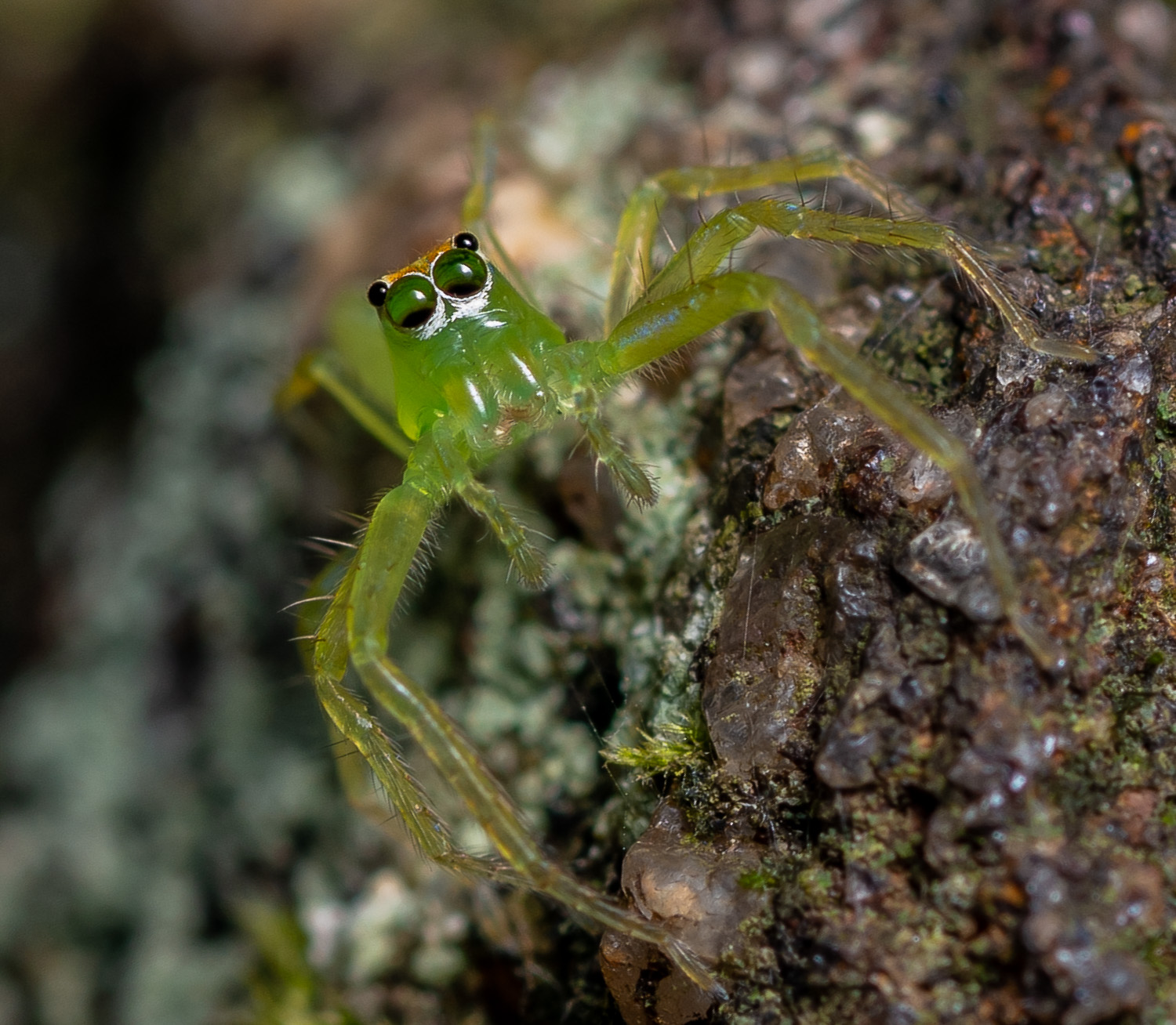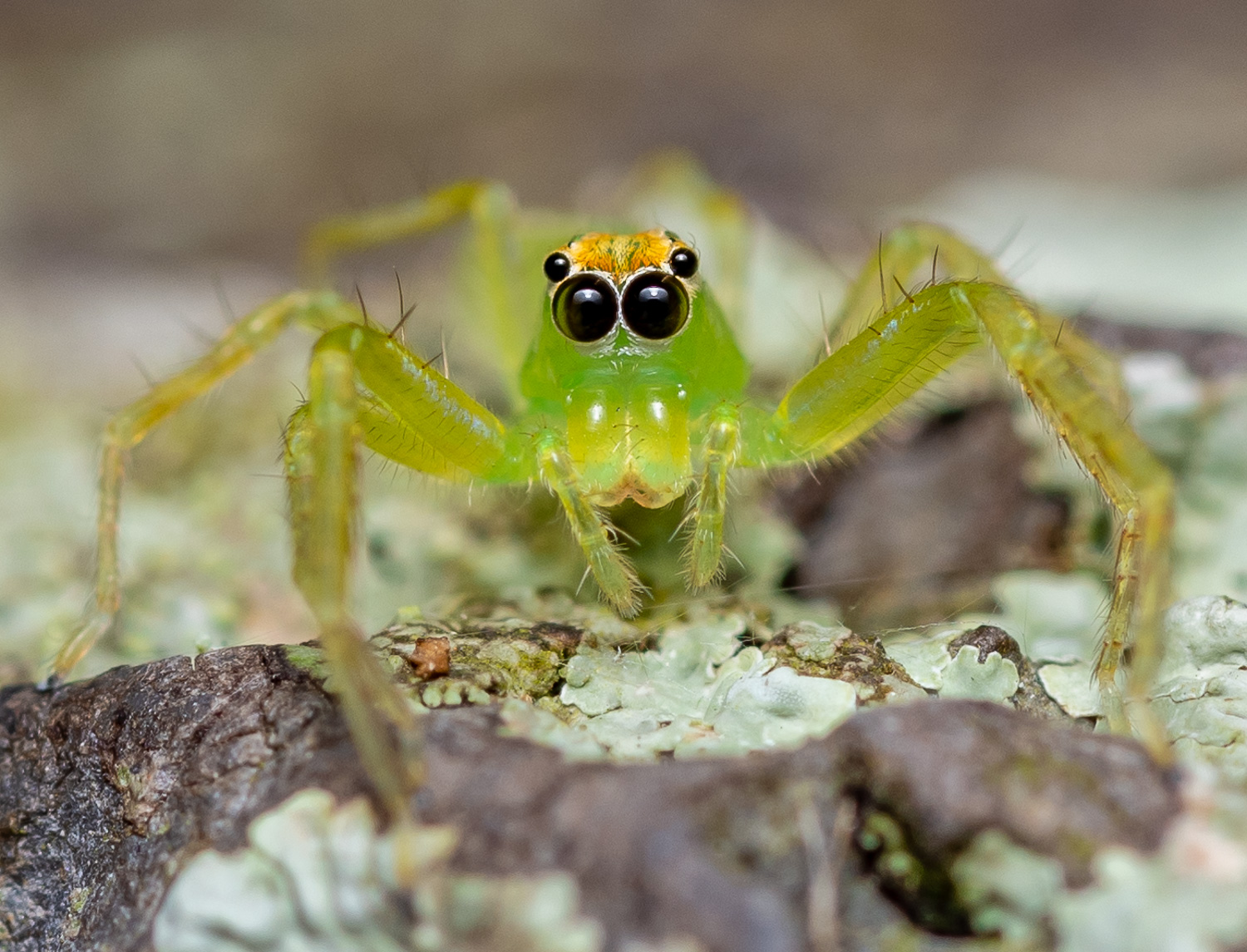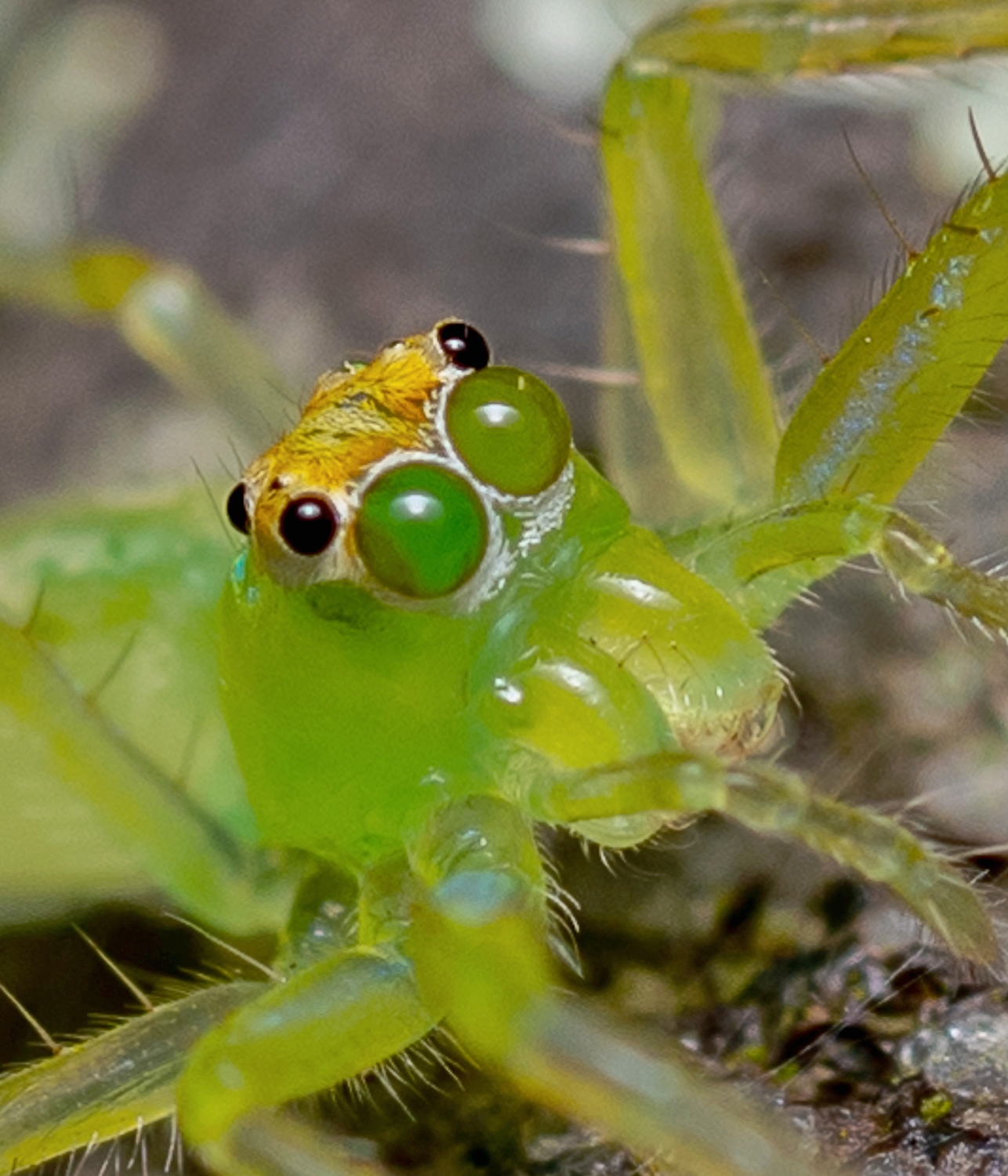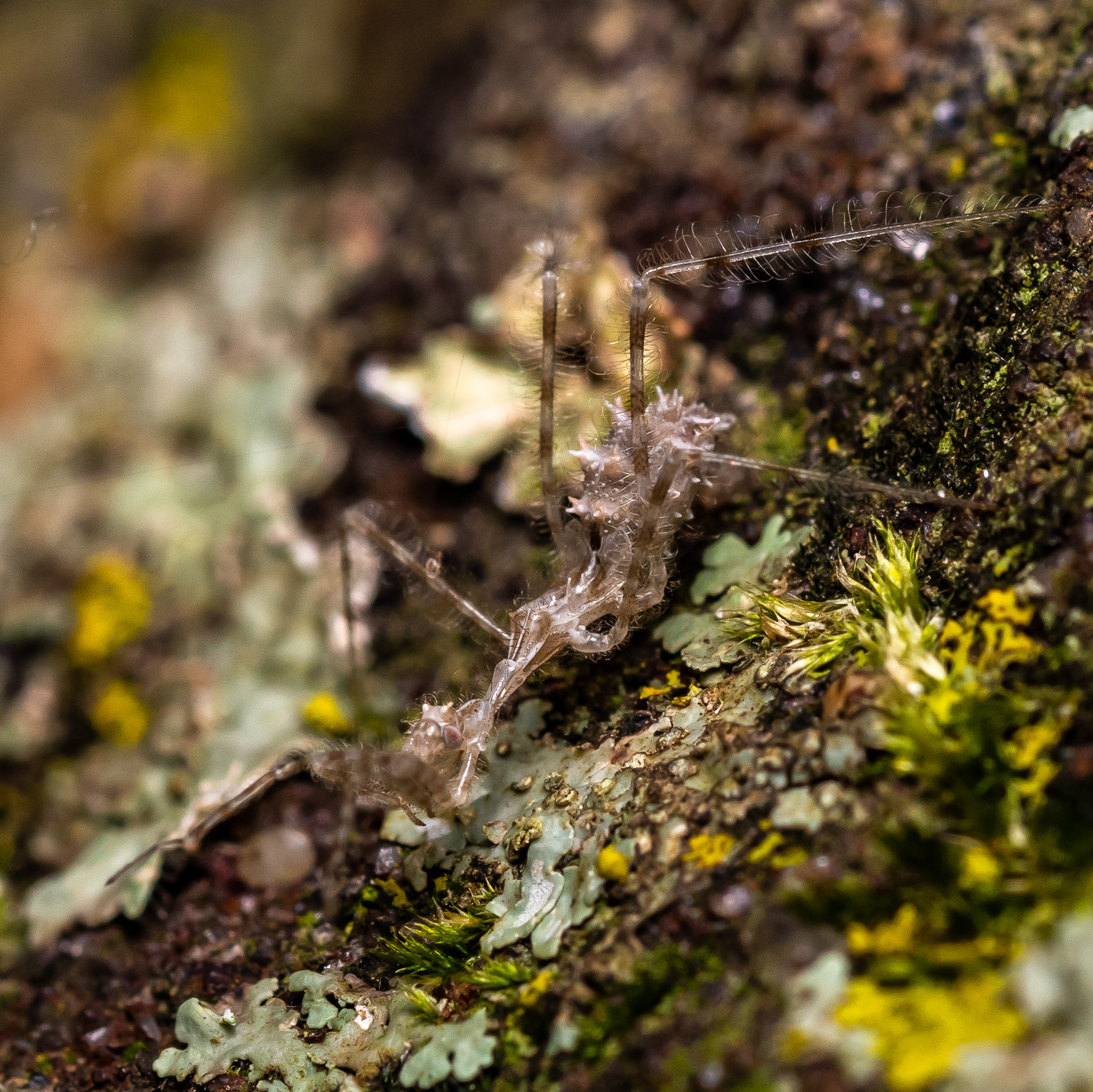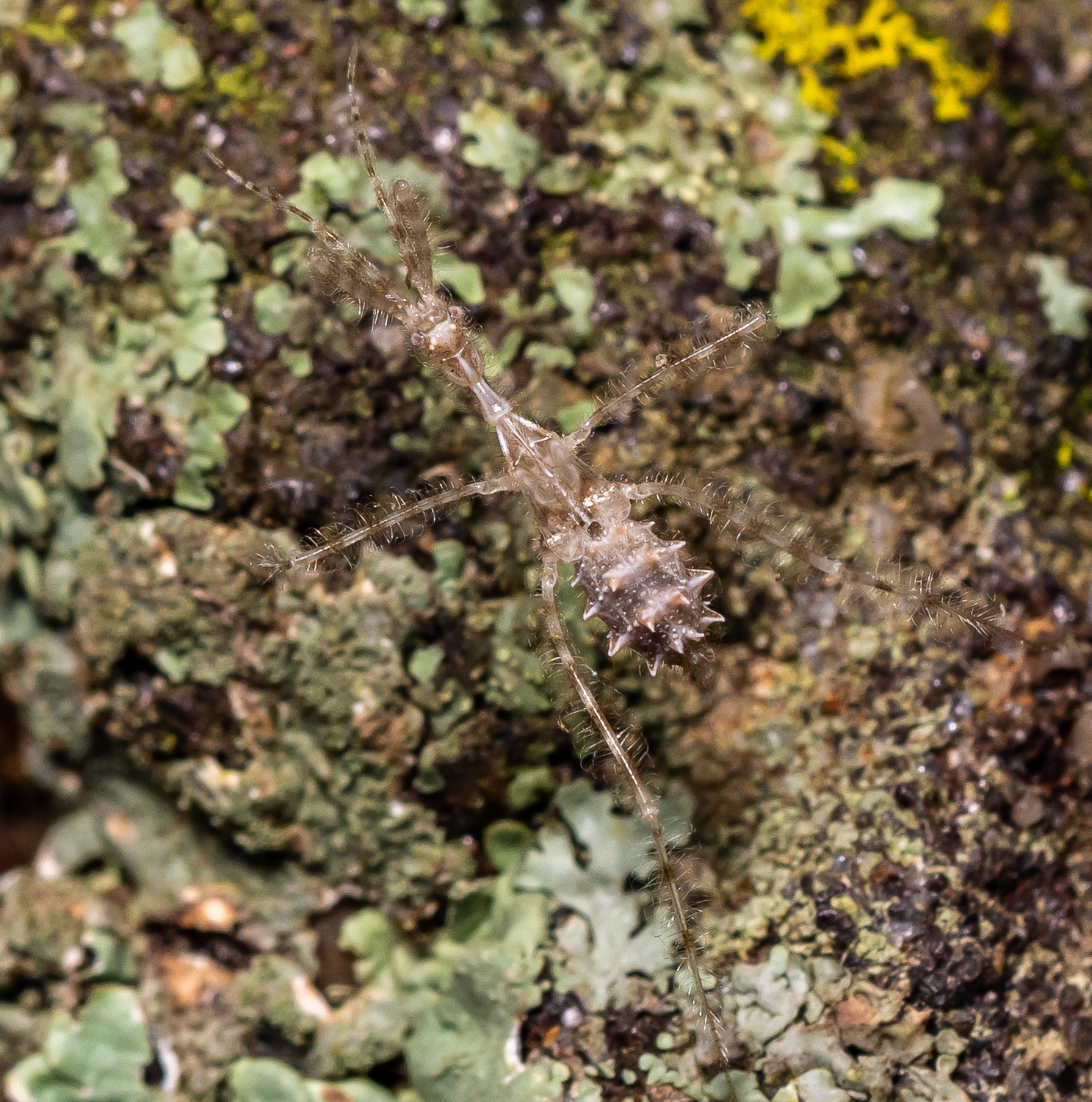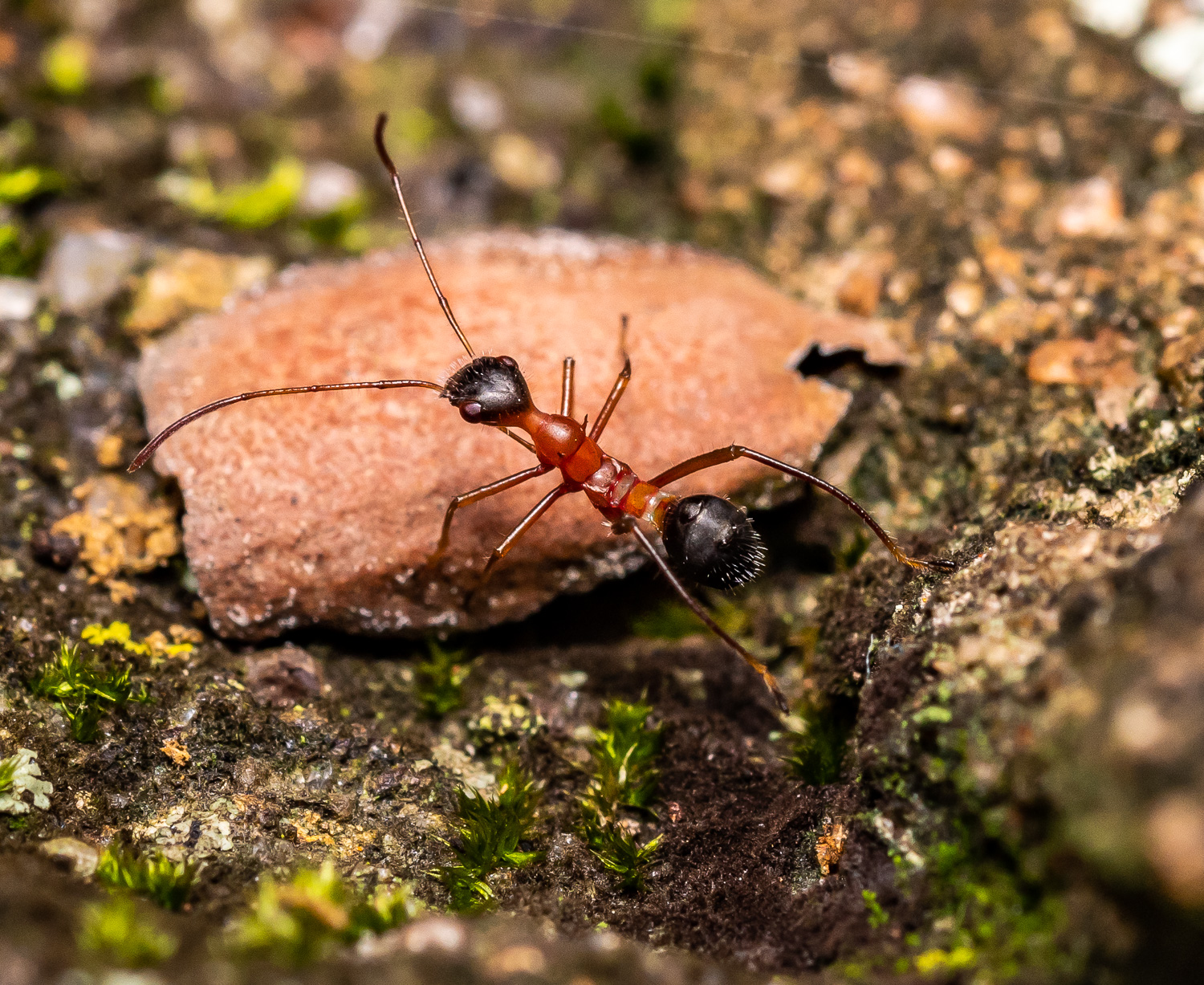Macro Photography Challenge: One Rock in One Hour
/When I’m out photographing bugs, I often wonder how much amazing stuff I’m missing. I don’t look under every leaf, or move every stick. Nobody does that. And to be honest, much of the time, when I should be paying attention to the bush I’m standing next to, I’m already looking down the path and scoping out the next promising tree or rock.
So I decided to set a challenge for myself. A challenge that would force me to slow to a crawl (literally) and see what I could find to photograph if I stayed in one spot, not budging for one hour.
Here it is… the focus of my attention for the next hour
And this was the obvious choice. This rock, Alabama’s answer to Stonehenge (I presume), sits all alone in a small clearing, in an acre or so of sparse woodland, a short walk from my house. It is only about 50-inches tall, with plenty of nooks and crannies, with lichens and mosses on every surface. Looking over my rock, I was struck by how barren and devoid of life it appeared. I was feeling like one of Kubrick’s apes, gawking at the odd obelisk that crashed their family reunion, in “2001: A Space Odyssey”.
After walking around the rock a few times, I was fairly certain that this was not quite as brilliant an idea as it had first seemed. Nevertheless, I had set myself a challenge and, even if I didn’t see a single living organism (besides lichen or moss), there would still be value in taking this hour to slow down and enjoy the peace and quiet. I was doing just that when, out of the corner of my eye, I saw movement. I had to stare at the spot for a couple of minutes before it happened again and, when it did, I made out a tiny grey dot picking its way across the top of my rock.
Euparius marmoreus - a fungus weevil
Fungus weevils (never knew they existed, by the way) are really tiny, beetle-like insects. They are also incredibly well camouflaged. Just seeing this insect with the naked eye felt like a victory and gave me fresh hope that there may be other, equally invisible inhabitants lurking in the shadows. There are several features of this tiny insect that reminded me of the white-fringed beetle (Naupactus), which is also a weevil, but is quite a bit larger than this minute specimen. Either way, it’s a weevil.
For those with an interest in such matters, all of these photographs were captured using a Nikon D850 with the Tamron 90mm f/2.8 Di VC USD and a single camera-mounted speedlight. The flash was diffused by a single sheet of tracing paper attached to the top of the speedlight and the front of the lens hood. All shots were handheld. Each face of my rock posed a different set of exposure challenges - for example, the top was relatively light-colored and in direct sunlight while the north-facing vertical was covered in dark green moss and shaded. My camera settings were, therefore, constantly changing, with shutter speeds from 1/125-250, apertures from f/4 to f/14, and ISO settings from 64 to 1600. The flash was managed manually with power settings ranging from 1/64 to 1/4.
I suddenly had the distinct impression that I was being watched…
Well, I was. And it was by a magnolia green jumper, or to be more precise, a Lyssomanes jumping spider. His name, by the way, is Marvin and he became my constant companion for the remainder of the hour. In case you were wondering why my new orange-haired guide gets three full-size pictures, it was because he would strike a practiced spider-pose every time I paid attention to him. He followed me every inch of every circuit around my rock (…his rock? …our rock?) and during our time together he took a number of brief, off-rock vacations to explore my camera, my arms, and my hat. Almost every time my lens was within a safe jumping distance, he would make the leap and then dash off to examine whatever had caught one of his eight eyes.
Why do I find Marvin’s attentions flattering, yet find the intense attention paid by the squadron of mosquitos that has remained by my side all summer to be a torment? I have a couple of theories, but the most compelling of them is probably that Marvin never tried to suck my blood.
Seeing nothing on my next circuit of the rock, I decided to get closer and use the lens to explore promising moss-forests and lichen-savannas. And that is how I came face-to-face, if you could call it a face, with this alarming beast…
At little more than a millimeter in length, this Stenolemus assassin bug nymph was hard to see even with the magnification from my lens. The pictures don’t do justice to the weirdness of this landlocked seahorse of an insect. Its locomotion is unlike anything I’ve seen in the insect world (and is probably unusual on mars, too). The creature doesn’t walk, per se, and instead vibrates its way, in no particular direction and with no apparent destination, back and forth over the terrain. Extremely weird and captivating to watch.
These assassin bug nymphs are only slightly smaller than they will be as adults. But, if you are a spider, it will serve you well not to let their extreme wee-ness lull you into a false sense of security. Sensing danger, Marvin took refuge on my lens hood. Stenolemus, you see, eats spiders. In fact, it kills and eats spiders that are many times larger than itself, even as a nymph! Imagine yourself pouncing onto the roof of a double-decker London bus and thrusting your rostrum in through a window and then, after injecting your gastric juices into the bus, sucking out the liquified passengers. OK, too graphic. But you get the point.
15 minutes later and I was beginning to wonder if I had found everything that was hanging out on my lonely rock. No sooner had that thought crossed my mind when this scruffy and disoriented character made a crash landing on my rock’s plateau.
For some reason, probably the crash landing and disheveled appearance, I was pretty confident that this individual must have been the Han Solo of Asian ladybird beetles.
This is but one of many ladybird species that make their home in the US. Originally from Asia, this species was imported to North America in an attempt to control the massive populations of aphids (a ladybird’s preferred snack) that were devastating American crops in the late 1970s. Depending on where you live, Harmonia axiridis goes by a variety of other common names, such as the harlequin lady bug and the halloween ladybird. Towards the end of summer, especially here in the south, these many-spotted beetles are known to congregate in staggering numbers. Preferring to over-winter indoors, it is not uncommon for these agricultural helpers to become annoying household pests - ask anyone who has come home from work to find 10,000 spotty-squatters having a rave in their living room.
I spend a bunch of time looking at bugs and, if I say so myself, have become reasonably proficient with identification. My next encounter, however, had me fooled.
A broad head bug nymph - a truly impressive ant-mimic
When this tiny “ant” appeared, I didn’t give it a second thought. I took several pictures and jotted “ant” in my notebook. Later, at the computer, I got a much closer look and was able to see my mistake. This amazing creature is not an ant at all, but an immature (nymph) member of the genus Alydidae, or broad head bug. It is a member of the Heteroptera, or true bugs, and a close relative of the stink bugs. The identification is made by looking at the bug’s mouthparts. All three pictures (above) clearly show the elongated rostrum, held flat against the underside of the body. The rostrum is a feature common to all true bugs (Heteroptera) and is used for piercing and sucking (sap, in the case of vegetarians like the squash bug, or body fluids for carnivores like the assassin bug).
Not only do these mimics look just like tiny ants, they also move like them. In fact, it was the very characteristic ant-like movement of this bug that had me fooled.
With the sunlight fading, it was getting difficult to pick up the tiny movements that had given away my last couple of finds. But I didn’t need much light to spot this hairy fungus beetle:
This was an unfamiliar beetle and I’m not 100% certain of the identification. I am fairly comfortable that it is a member of the Tenebrionoidea, a group of insects that includes the fungus, blister, bark, and darkling beetles. It might be a red-legged darkling beetle, but the hairy outer wings (elytra) convinced me otherwise. That and the fact that it was grazing on a patch of fungus. If this is a fungus beetle, and I am ready to be corrected on this one, it was not in its typical habitat. This beetle is more commonly found in poorly maintained grain and tobacco storage containers, where fungus growth may be found. I carefully checked the rock for any grain silos or cigar factories that I might have missed, to no avail.
My hour was up and it was time to pack up my gear and head home. The rock, apparently, had a better idea. As if the rock had been saving the best for last, out from a small crevice hopped this gorgeous jumping spider:
Platycryptus undatus - AKA the tan jumping spider
I’m a huge fan of jumping spiders, in case you hadn’t guessed. I think it is the huge eyes and “raised eyebrows” that make them so appealing. Humans are attracted to pretty much anything with big eyes - it’s an evolution thing - and these eyes are no exception. Truth be known, these are fairly vicious carnivores, with massive fangs, plump poison glands, and voracious appetites. They don’t build a web and spend most of their time hunting for flies that wander into their neighborhoods. They do make silk but mostly use single strands either as parachutes (to travel distances) or as bungee cords (in case they miss their target when pouncing on prey).
One more pose…
Identification of jumping spiders can be very challenging, especially so given the huge variety of species in my neck of the woods. This particular specimen is showing off her characteristic spiked eyebrow tufts - a useful key to the identification. In both of these pictures she is using her bushy pedipalps (the frontmost pair of legs - used to crush prey) to cover her gigantic fangs but, if you look closely, you can see the bulging red chelicerae below her eyes.
There was one final visitor that is worthy of a mention. He wasn’t actually on the rock and my hour was up, but I’m going to include him anyway. He was in my camera bag, inspecting my backup camera, when I found him.
Anasaitus canosa - the twin-flagged jumping spider
He was a small male twin-flagged jumping spider, very common around here. I introduced him to his new home (the rock) and took a quick picture of his sad face (clearly he was missing my camera bag).
So, with my hour over and the light gone, I called it a day, bid farewell to Marvin, and headed home. On reflection, this was a valuable learning experience for me. Macro photography tests our patience and concentration at the best of times, but this “one-hour-one-microhabitat” challenge pushes it to the limit. The fascinating inhabitants of my rock were there all along (except Han Solo, who was just passing through) but to see them I had to slow way down and look real close. You should give it a try too.
Have you ever tried this type of challenge? I would love to hear about what you did and what you found. Leave a comment below and, as always, don’t hesitate to ask a question, make a suggestion, or correct me where I was wrong.
Until next time - see you in the bushes!




